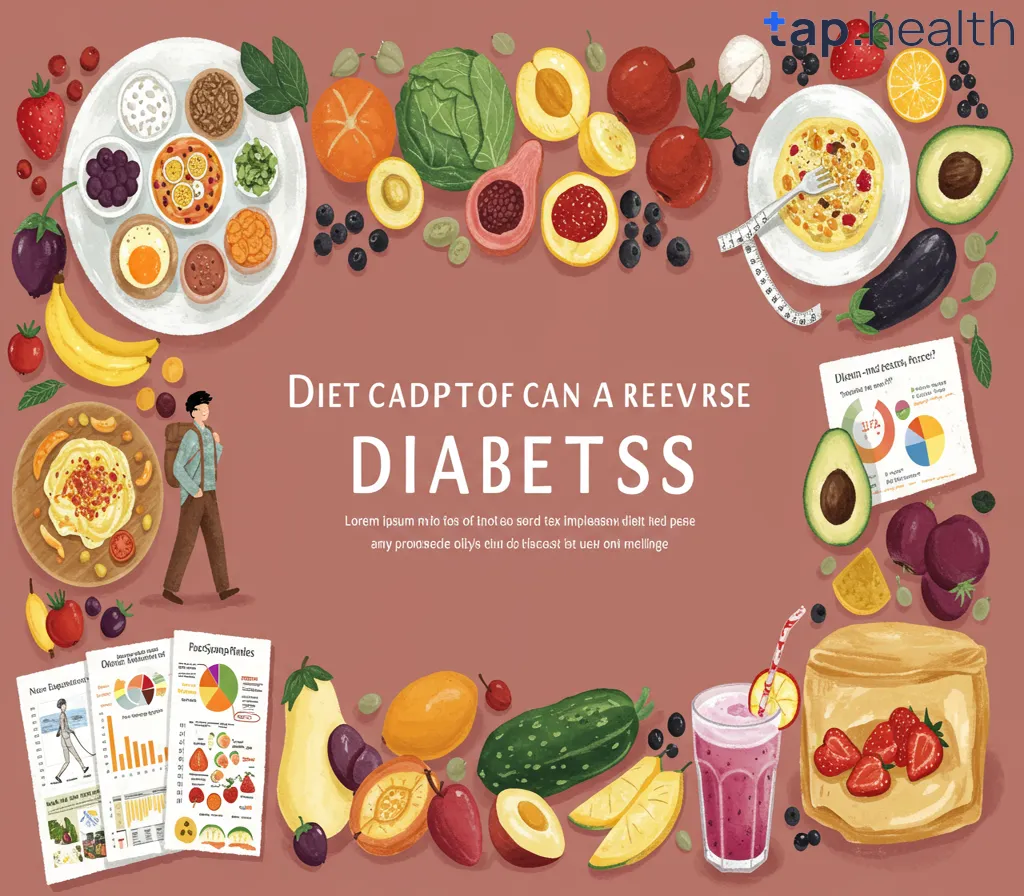Diabetes, particularly type 2 diabetes, has become a global health concern. But here’s some good news: a balanced diet can help manage, and in some cases, reverse type 2 diabetes. While medication is important in managing diabetes, the foods you eat and your lifestyle choices can play an equally significant role in improving blood sugar control.
In this guide, we’ll explore the diet that can help reverse diabetes. You’ll learn about the foods that support healthy blood sugar levels, the ones to avoid, and how you can create a nutrition plan that works for you. If you’re committed to changing your eating habits and taking charge of your health, this article will give you the tools and information you need to start your journey towards reversing diabetes.
Understanding Type 2 Diabetes
Before diving into the specifics of a diabetes-reversal diet, it’s essential to understand what type 2 diabetes is and how it affects your body.
Type 2 diabetes occurs when your body either becomes resistant to insulin or doesn’t produce enough insulin to keep blood sugar levels in check. This results in elevated blood sugar, which can damage various organs and lead to long-term health problems if not managed.
Can Type 2 Diabetes Be Reversed?
Yes, it is possible to reverse type 2 diabetes, especially if it is caught early. Lifestyle changes, including diet and exercise, can help lower blood sugar levels, improve insulin sensitivity, and even lead to the remission of diabetes.
The key is adopting a sustainable, long-term approach that focuses on healthy eating, regular physical activity, and stress management. One of the most effective tools in this process is diet.
What Foods Help Reverse Diabetes?
There is no single “magic” food that can reverse diabetes, but eating a balanced diet full of nutrient-dense foods can help lower blood sugar levels, improve insulin sensitivity, and reduce inflammation. Here are the key components of a diet that can help reverse diabetes:
1. Low-Glycemic Foods
Foods with a low glycemic index (GI) are slower to break down into glucose, which means they don’t cause spikes in blood sugar. The lower the GI, the better it is for your blood sugar levels.
Examples of Low-Glycemic Foods:
- Non-starchy vegetables (e.g., spinach, broccoli, cauliflower, kale)
- Whole grains (e.g., quinoa, brown rice, barley)
- Legumes (e.g., beans, lentils, chickpeas)
- Fruits like berries, apples, and pears (in moderation)
- Sweet potatoes (instead of regular white potatoes)
2. Fiber-Rich Foods
Fiber helps regulate blood sugar by slowing down the absorption of sugar into the bloodstream. It also helps in weight management, which is important for controlling blood sugar levels.
Examples of High-Fiber Foods:
- Leafy greens (spinach, kale)
- Whole grains (oats, brown rice, quinoa)
- Legumes (lentils, beans, peas)
- Nuts and seeds (chia seeds, flaxseeds, almonds)
- Fruits with edible skins (berries, apples, pears)
3. Healthy Fats
While fats have been demonized in the past, healthy fats are actually an essential part of a diabetes-reversal diet. Healthy fats can help improve insulin sensitivity, lower inflammation, and reduce the risk of heart disease, which is especially important for people with diabetes.
Examples of Healthy Fats:
- Avocados
- Olive oil and coconut oil
- Fatty fish like salmon, mackerel, and sardines (rich in omega-3 fatty acids)
- Nuts and seeds (almonds, walnuts, chia seeds)
4. Lean Protein
Protein helps stabilize blood sugar levels and supports muscle growth and repair. Including lean protein in your meals will keep you feeling full for longer and help manage hunger and blood sugar levels.
Examples of Lean Protein:
- Skinless poultry (chicken, turkey)
- Fish and seafood
- Tofu and tempeh
- Eggs
- Legumes (lentils, beans)
5. Anti-Inflammatory Foods
Chronic inflammation is linked to insulin resistance and the development of type 2 diabetes. Eating foods that help reduce inflammation can improve insulin sensitivity and help lower blood sugar levels.
Examples of Anti-Inflammatory Foods:
- Berries (strawberries, blueberries)
- Green tea
- Turmeric (curcumin is a powerful anti-inflammatory compound)
- Olive oil
- Leafy greens (kale, spinach)
- Nuts (walnuts, almonds)
6. Herbs and Spices
Certain herbs and spices have been shown to have a positive impact on blood sugar regulation. Incorporating these into your meals can be beneficial.
Examples of Helpful Herbs and Spices:
- Cinnamon: Known to improve insulin sensitivity.
- Ginger: May help lower blood sugar and reduce inflammation.
- Fenugreek: Shown to lower blood sugar levels in some studies.
- Garlic: Contains compounds that improve insulin sensitivity.
What Foods Should Be Avoided to Reverse Diabetes?
While there are plenty of foods that help reverse diabetes, there are also foods you should avoid. Certain foods can cause blood sugar spikes and contribute to insulin resistance, making it harder to manage diabetes.
1. Sugary Foods and Beverages
Sugary foods and drinks are a major contributor to high blood sugar levels. This includes soda, sweetened juices, pastries, candy, and sugary snacks. These foods cause rapid spikes in blood glucose and provide little nutritional value.
2. Refined Carbs
Refined carbohydrates, such as white bread, white rice, and pasta, are quickly broken down into sugar in the body, causing blood sugar levels to rise. Instead, opt for whole grains like brown rice, quinoa, and oats.
3. Processed Foods
Processed foods are typically high in unhealthy fats, refined carbs, and added sugars, making them bad for your blood sugar levels. Avoid packaged snacks, processed meats, and fast food.
4. Trans Fats
Trans fats, often found in baked goods, fried foods, and margarine, can contribute to insulin resistance and inflammation. Avoid these types of fats and stick to healthy fats like those found in olive oil, avocados, and fatty fish.
5. Alcohol
While small amounts of alcohol can be part of a healthy diet, excessive alcohol consumption can cause blood sugar fluctuations and liver damage. If you choose to drink, do so in moderation and monitor your blood sugar closely.
How to Plan a Diet That Can Reverse Diabetes
To create a sustainable diet that helps reverse diabetes, consider these guidelines:
1. Eat Balanced Meals
Aim for balanced meals that include lean protein, healthy fats, fiber-rich carbohydrates, and plenty of vegetables. A healthy plate should consist of:
- 50% non-starchy vegetables
- 25% lean protein
- 25% whole grains or legumes
2. Focus on Portion Control
Even healthy foods can contribute to weight gain if eaten in large amounts. Practice portion control and aim to eat smaller meals more frequently throughout the day to keep your blood sugar levels stable.
3. Track Your Carbs
Carbohydrates directly affect blood sugar levels. Keep track of your carb intake, and choose high-fiber, low-GI carbs over refined and processed ones. A food diary or a nutrition app can be helpful for monitoring your intake.
4. Stay Hydrated
Water is essential for overall health and can help regulate blood sugar. Aim to drink at least 8 glasses of water a day. Avoid sugary drinks, which can spike blood sugar levels.
5. Limit Eating Out
When you eat out, it’s often harder to control the ingredients in your food, especially unhealthy fats and added sugars. Cooking at home allows you to control the ingredients and portion sizes.
Exercise: The Missing Piece in Reversing Diabetes
While diet plays a major role in reversing diabetes, exercise is equally important. Physical activity helps improve insulin sensitivity and lowers blood sugar levels. Regular exercise can also help with weight management, which is a key factor in managing and reversing diabetes.
1. Cardio Exercise
Engage in regular cardiovascular exercise, such as walking, cycling, or swimming, to improve blood circulation and insulin sensitivity.
2. Strength Training
Building muscle mass through strength training exercises, such as lifting weights or resistance bands, helps your body use glucose more efficiently.
3. HIIT (High-Intensity Interval Training)
Studies show that HIIT can improve insulin sensitivity and help lower blood sugar levels. Short bursts of intense activity followed by rest can be effective in managing blood sugar.
Can a Diet Alone Reverse Diabetes?
While a healthy diet is crucial in managing and reversing type 2 diabetes, it is usually not enough on its own. A comprehensive approach, which includes regular exercise, stress management, and proper sleep, is essential for long-term success.
1. Exercise and Lifestyle Changes
Diet and exercise go hand-in-hand in reversing diabetes. Physical activity improves insulin sensitivity, helping your body process glucose more efficiently. Adequate sleep and stress management are also important in managing blood sugar levels.
2. Medication
In some cases, medication may be needed to help manage blood sugar levels, particularly in the early stages of diabetes. However, with sustained lifestyle changes, it is possible to reduce or even eliminate the need for medication over time.
Frequently Asked Questions (FAQs) on Diet That Can Reverse Diabetes: A Complete Guide
1. Can a diet really reverse diabetes?
Yes, a healthy, balanced diet, combined with regular exercise and lifestyle changes, can help reverse or significantly improve type 2 diabetes. It’s important to focus on low-GI foods, fiber, lean proteins, and healthy fats.
2. How long does it take to reverse diabetes with diet?
The time it takes to reverse diabetes varies from person to person. However, many people begin to see improvements within 2-3 months with consistent diet and lifestyle changes.
3. Can I eat fruit on a diabetes-reversal diet?
Yes, you can eat fruit in moderation. Choose fruits with a low glycemic index, such as berries, apples, and pears. Avoid high-sugar fruits like bananas, grapes, and pineapples in excess.
4. Is there a “diabetes-reversal” diet plan?
There isn’t a one-size-fits-all diabetes-reversal diet. However, following a balanced diet that includes low-GI foods, high fiber, healthy fats, and lean proteins can help manage and reverse diabetes.
5. What are the best exercises to reverse diabetes?
Cardiovascular exercise (like walking and swimming), strength training (like lifting weights), and high-intensity interval training (HIIT) are all effective for improving insulin sensitivity and lowering blood sugar levels.
Conclusion
Reversing diabetes through diet is not a quick fix, but with dedication and the right approach, it is absolutely possible. By eating a balanced diet, rich in low-GI foods, fiber, healthy fats, and lean proteins, and combining this with regular exercise and other lifestyle changes, you can regain control over your health and potentially reverse your diabetes. Always consult with your healthcare provider before making any significant changes to your diet or exercise routine. Start today and take the first step toward a healthier life!



